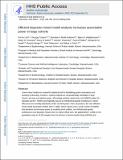| dc.contributor.author | Loh, Po-Ru | |
| dc.contributor.author | Bulik-Sullivan, Brendan K | |
| dc.contributor.author | Vilhjálmsson, Bjarni J | |
| dc.contributor.author | Salem, Rany M | |
| dc.contributor.author | Chasman, Daniel I | |
| dc.contributor.author | Ridker, Paul M | |
| dc.contributor.author | Neale, Benjamin M | |
| dc.contributor.author | Patterson, Nick | |
| dc.contributor.author | Price, Alkes L | |
| dc.contributor.author | Tucker, George Jay | |
| dc.contributor.author | Finucane, Hilary Kiyo | |
| dc.contributor.author | Berger Leighton, Bonnie | |
| dc.date.accessioned | 2017-06-22T21:32:59Z | |
| dc.date.available | 2017-06-22T21:32:59Z | |
| dc.date.issued | 2015-03 | |
| dc.date.submitted | 2014-07 | |
| dc.identifier.issn | 1061-4036 | |
| dc.identifier.issn | 1546-1718 | |
| dc.identifier.uri | http://hdl.handle.net/1721.1/110185 | |
| dc.description.abstract | Linear mixed models are a powerful statistical tool for identifying genetic associations and avoiding confounding. However, existing methods are computationally intractable in large cohorts and may not optimize power. All existing methods require time cost O(MN2) (where N is the number of samples and M is the number of SNPs) and implicitly assume an infinitesimal genetic architecture in which effect sizes are normally distributed, which can limit power. Here we present a far more efficient mixed-model association method, BOLT-LMM, which requires only a small number of O(MN) time iterations and increases power by modeling more realistic, non-infinitesimal genetic architectures via a Bayesian mixture prior on marker effect sizes. We applied BOLT-LMM to 9 quantitative traits in 23,294 samples from the Women's Genome Health Study (WGHS) and observed significant increases in power, consistent with simulations. Theory and simulations show that the boost in power increases with cohort size, making BOLT-LMM appealing for genome-wide association studies in large cohorts. | en_US |
| dc.description.sponsorship | National Institutes of Health (U.S.) (grant R01 HG006399) | en_US |
| dc.description.sponsorship | National Institutes of Health (U.S.) (fellowship F32 HG007805) | en_US |
| dc.description.sponsorship | Hertz Foundation | en_US |
| dc.language.iso | en_US | |
| dc.publisher | Nature Publishing Group | en_US |
| dc.relation.isversionof | http://dx.doi.org/10.1038/ng.3190 | en_US |
| dc.rights | Creative Commons Attribution-Noncommercial-Share Alike | en_US |
| dc.rights.uri | http://creativecommons.org/licenses/by-nc-sa/4.0/ | en_US |
| dc.source | PMC | en_US |
| dc.title | Efficient Bayesian mixed-model analysis increases association power in large cohorts | en_US |
| dc.type | Article | en_US |
| dc.identifier.citation | Loh, Po-Ru, George Tucker, Brendan K Bulik-Sullivan, Bjarni J Vilhjálmsson, Hilary K Finucane, Rany M Salem, Daniel I Chasman, et al. “Efficient Bayesian Mixed-Model Analysis Increases Association Power in Large Cohorts.” Nat Genet 47, no. 3 (February 2, 2015): 284–290. © 2015 Nature America, Inc. | en_US |
| dc.contributor.department | Massachusetts Institute of Technology. Computer Science and Artificial Intelligence Laboratory | en_US |
| dc.contributor.department | Massachusetts Institute of Technology. Department of Mathematics | en_US |
| dc.contributor.mitauthor | Tucker, George Jay | |
| dc.contributor.mitauthor | Finucane, Hilary Kiyo | |
| dc.contributor.mitauthor | Berger Leighton, Bonnie | |
| dc.relation.journal | Nature Genetics | en_US |
| dc.eprint.version | Author's final manuscript | en_US |
| dc.type.uri | http://purl.org/eprint/type/JournalArticle | en_US |
| eprint.status | http://purl.org/eprint/status/PeerReviewed | en_US |
| dspace.orderedauthors | Loh, Po-Ru; Tucker, George; Bulik-Sullivan, Brendan K; Vilhjálmsson, Bjarni J; Finucane, Hilary K; Salem, Rany M; Chasman, Daniel I; Ridker, Paul M; Neale, Benjamin M; Berger, Bonnie; Patterson, Nick; Price, Alkes L | en_US |
| dspace.embargo.terms | N | en_US |
| dc.identifier.orcid | https://orcid.org/0000-0003-3864-9828 | |
| dc.identifier.orcid | https://orcid.org/0000-0002-2724-7228 | |
| mit.license | OPEN_ACCESS_POLICY | en_US |
